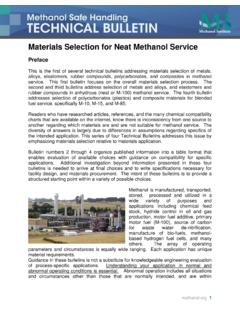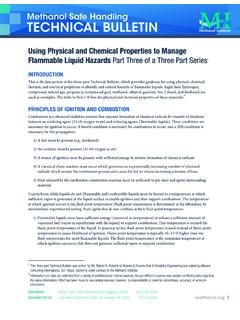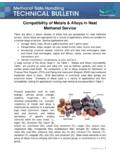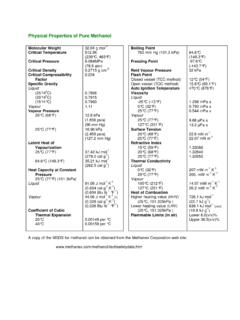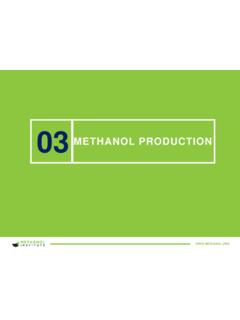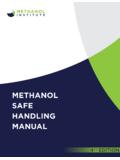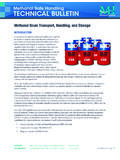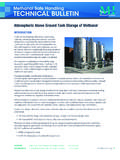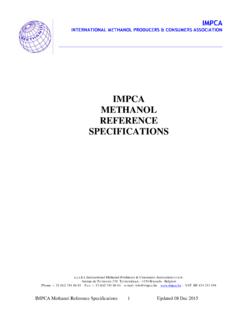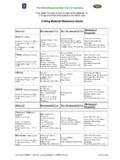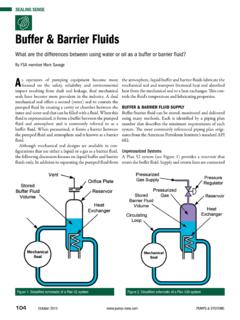Transcription of Compatibility of Elastomers in Neat Methanol …
1 1 Compatibility of Elastomers in neat Methanol Service Elastomers and rubber compounds are widely used in Methanol service as O-rings, gaskets, packing, and sealing materials to prevent leakage of Methanol liquid and vapors into the surrounding environment. As originally used, the term rubber described materials that occurred naturally in nature. The term elastomer designated synthetically produced polymers characterized by their elastic properties. The terms are essentially interchangeable in current usage. This bulletin uses the term elastomer to indicate synthetic and natural compounds. Elastomer performance is limited by temperature, pressure, and Compatibility of the polymer sealing material with chemical properties of the contained fluid. These limitations are important considerations in meeting toxic fluid leakage issues addressed in Chapter VIII of the American Society of Mechanical Engineers Process Piping Code, , and complying with fugitive emission regulations.
2 Elastomer applications typically assume several functional types: O-rings, gaskets, gland seals, and packings. Each functional type requires compounding and forming the polymer into a characteristic geometry necessary to satisfy the function. O-rings are solid circular rings; gaskets are cut from flat material; seals are often composite configurations of polymer and alloys or thermal plastics; packings are typically circular or rectangular ropes. Sealing applications are compressors, pumps, piping connections, valves, and instrumentation elements where the polymers are subject to static or flowing service over a wide range of temperatures and pressures. Operating conditions can be constant, fluctuating or cyclical. Polymers that are suitable for one type of service ( , O-rings, gaskets, seals or packing) may not be suitable for any another service in spite of the fact that they are exposed to the same chemical.
3 Temperature and pressure are major determinates in selecting Elastomers for a particular service. Materials Selection for neat Methanol Service (cont.) 2 Small Polar Fluid Molecules Can Be Aggressive to Polymers Polymers are subject to several forms of deterioration in Methanol sealing service. The first of these is swelling. Liquids with small polar molecules such as Methanol can be aggressive in causing elastomer and rubber compound matrices to swell. Excessive swelling causes the polymer to burst within the confinement of O-ring grooves thereby creating a path for fluid leakage. If confining pressure is sufficiently high, failure can result in a small jet stream of Methanol liquid that flashes to vapor. Chemical attack is a second form of deterioration. Process fluids can chemically attack and destroy the integrity of the polymer, thus also creating a path for fluid leakage.
4 Polymer failure in this case may result in a leak before break type of failure mode. A third, and potentially the most hazardous deterioration mechanism can occur by explosive decompression (ED). Explosive decompression subjects sealed joints to abrupt, unexpected, catastrophic containment failure. Explosive decompression occurs when liquid process fluid vaporizes upon decompression, thereby transmitting abrupt pressure, temperature, and flow fluctuation transients across the sealing surface into the plant working environment, and possibly upstream and downstream from the point of failure through equipment and piping works. Fluid movement across the sealing surface can disrupt positioning of the gasket or O-ring thereby increasing leak rate. Explosive decompression is essentially blows the sealing polymer out of the gap between the sealing surfaces.
5 Pressure classes above 600 lbs require ED resistant O-rings: , O-rings that are tested in conditions representing the actual fluid, fluid pressure, and fluid temperature (refer to NORSOK M-710). The most important criteria for explosive decompression resistant O-rings are shore-hardness greater than 90, and cross section less than 7 mm. Each deterioration mechanism dictates application limits of a particular polymer in a particular service. In spite of gains during the past 20 years, elastomer gaskets in piping connections, and O-ring components in valves are the single most significant limiting factor on process system operating window. Polymer O-rings provide excellent sealing performance at low cost; however, strength, pliability, and resilience characteristics required for proper Materials Selection for neat Methanol Service (cont.) 3 sealing need to be maintained throughout the entire operating window, including abnormal operating conditions.
6 At low temperature, Elastomers harden, become less resilient and lose shape memory. Undesirable experience causes some operators to avoid using Elastomers in applications below a design temperature of -4oF (-20oC). The upper temperature limit of Elastomers in Methanol service is determined by the chemical characteristics of the elastomer relative to those of Methanol . As operating temperature increases, chemically similar Elastomers are affected more than Elastomers that are chemically dissimilar to Methanol . Because the rate of elastomer degradation increases as temperature increases, establishing a realistic temperature limit is vitally important in setting operating temperature window. Operating a piping works outside a selected elastomer s sealing capability subjects the entire piping works to losing its containment capability.
7 It is prudent to verify sealing limitations with the seal manufacturer, and to restrict temperature to an upper limit of 250-300oF (120 and 150oC) and a lower limit of -4oF (-20oC), depending on piping pressure class. Description of Elastomer Sealant Materials Elastomer types are referenced using standard designations and acronyms listed in ASTM D-1418 and ISO 1629 international standards. A brief description of selected elastomer and thermoplastics characteristics are provided below. A more complete listing of material grades is available at FEP/PFA (Fluoroethylene Propylene-Perfluoroalkoxy) This type of elastomer is a chemically modified fluorocarbon copolymer (fluoropolymer) that resembles plastic more than it does rubber. These polymers are extremely resilient and show excellent chemical resistance. Mechanical properties are good, even at high temperatures, and they have non-stick characteristics with moderate abrasion resistance.
8 The published continuous exposure temperature range is from -148 to 360oF (-100 to 200oC) for FEP and -148 to 482oF (-100 to 250oC) for PFA. Typical applications are door seals and sealing systems in diaphragm pumps, cryogenic plants, sealed filter units, corrosive Materials Selection for neat Methanol Service (cont.) 4 fluid plants and relief and emergency valves and pneumatics. Fluoropolymers can be used to encapsulate other Elastomers to produce composite seals. Virgin Teflon FEP is considered an excellent choice for flange gaskets in Methanol service. FFKM/FFPM (Perfluoroelastomer) FFKMs exhibit outstanding high temperature properties and as a rubber form of PTFE, they are the most chemically resistant elastomer available. FFKMs are superior to FKM Elastomers , showing continuous dry-heat resistance to 500oF (260oC) with extended performance to 626oF for high temperature grades.
9 They show excellent resistance to a majority of chemicals that attack other Elastomers , and have good long-term high temperature compression set resistance. Applications are sealing systems in oil refineries, pharmaceutical plants, aerospace applications and chemical plants. Perfluoroelastomer shows little or no effect from Methanol exposure. FVMQ (Fluorosilicone) FVMQ Elastomers are modified silicone rubbers, which have many of the properties associated with silicone rubber, but show improved oil and fuel resistance. Typical properties are resistance to ozone, oxygen, weathering, and non-adhesive characteristics. Service temperature range is wide and chemical reactivity is low. Tensile strength, tear resistance and abrasion resistance are poor, and gas permeability is high. Elastomer shows little or no effect from Methanol exposure.
10 IR (Polyisoprene) IR is a synthetic version of natural rubber with similar strength and applications. Low temperature performance exceeds that of rubber with inferior performance at normal temperatures. NBR (Nitrile or Acrylonitrile Butadine) Properties of this copolymer can be adjusted by changing the ratio of acrylonitrile and butadiene. Nitrile rubber can be classified as three types based on the acrylonitrile (ACN) content (low, medium, and high). Resistance to aromatic hydrocarbons is higher as ACN content increases. Low ACN content favors low temperature flexibility. The Materials Selection for neat Methanol Service (cont.) 5 most commonly specified, and the best overall balance for most applications is medium nitrile. General characteristics of NBRs are resistance to attack by aliphatic hydrocarbon oils, fuels, and greases, very low gas permeability, improved heat ageing and ozone resistance, improved tensile and abrasion strength, hardness, density, and low compress set.
